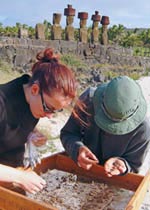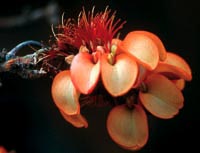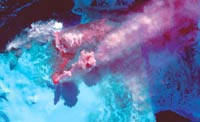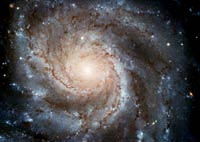Research News
- Professors suggest government abstain from distorted sex ed
- BRIEFLY: Names and histories
- Rapa Nui settlement estimates revised
- Nitric oxide levels not linked to altitude sickness
- Cigarette’s cancer risk linked to ethnicity
- Ethicists question artificial blood study
- Cars could fo from polluters to pollution collectors
- Wasps threaten coral trees
- Plankton’s role in ocean explored
- Common gene determines different body plans
- HOT SHOT: Antarctic eruption captured by satellite
- GEOPHYSICS: Ridge rocks and stretch marks yield clues in volcanology
- X-rays and radio waves reveal galaxy magnets and dust bunnies
- Composite image details pinwheel galaxy
Professors suggest government abstain from distorted sex ed
Offering abstinence-only sex education is akin to teaching driver’s ed by showing grisly pictures of traffic accidents without teaching students to stop at red lights or buckle their seatbelts, according to one of the numerous sources cited in a new article by two University of Hawaiʻi at Mānoa faculty members. Worse, it violates adolescents’ legal right to make informed choices, argued Professors Hazel Glenn Beh (law) and Milton Diamond (anatomy and reproductive biology) at the Columbia Journal of Gender and Law’s February 2006 symposium on sexuality and the law.
The heavily footnoted article reviews historical, biological, medical, economic, ethical and educational aspects of the political battle over what schools will teach.
At the beginning the 20th century, American schools adopted sex education to encourage restraint and promote Victorian values through graphic information on the consequences of venereal disease and the evils of promiscuity and prostitution. The need to educate soldiers headed into world wars and recognition that earlier puberty and prolonged adolescence were accompanied by increasing premarital sexual activity resulted in a broader curriculum.
Since 1999, however, federal funds have multiplied for programs that once again exaggerate the risks of abortion and sexually transmitted diseases and condone sexual relations only in the context of monogamous, heterosexual marriages.
The problem, according to the authors, is that there is no evidence abstinence-only programs are effective. Adolescents taking virginity pledges may delay sexual activity and have fewer partners, but most eventually engage in premarital sex. And when they do, they are less likely to use condoms correctly, if at all, and just as likely to contract STDs although less likely to be tested.
The article acknowledges lawmaker’s interest in advancing certain social values—the government can legitimately remain silent on sexual activity or fund programs that extol abstinence, the authors write. But dissemination of false and distorted information that impairs minors’ ability to make informed choices actually endangers their health and violates legal rights related to biological maturity.
Reviewing court precedents, the authors conclude: "The state’s right to convey its own message may not be had at the expense of a minor’s decisional and privacy rights in matters of their own sexuality."
top
BRIEFLY: Names and histories
- University of Hawaiʻi at Hilo Assistant Professor Mark Panek chronicles the life of the first foreigner to reach the highest ranks of Japanese sumo in Gaijin Yokozuna: A Biography of Chad Rowan (University of Hawaiʻi Press).
- University of Hawaiʻi at Mānoa Professor of Anthropology Michael Graves and affiliated graduate faculty member Kēhaunani Cachola–Abad received a 3–year, $100,000 grant to conduct archaeological research on Kamehameha the Great for We the People, a National Endowment for the Humanities project to encourage understanding of U.S. history and culture.
- A NASA comet-watch program has identified a new comet, named P/2005 VI Bernardi for Universit y of Hawaiʻi at Mānoa Astronomer Fabrizio Bernardi, who first spotted the comet on Halloween night images captured by the Canada-France-Hawaiʻi telescope. The comet orbits the sun every 10 years on a path too distant to be visible to the naked eye.

Rapa Nui settlement estimates revised
Excavations on Rapa Nui suggest colonization occurred 400–800 years later than previously thought.
Surprised by the radiocarbon dating results on samples excavated during an archaeological field school in a 2005 summer field school, University of Hawaiʻi at Mānoa Professor of Anthropology Terry Hunt and a colleague reevaluated previously published results.
When previous samples known to compromise dating techniques, such as marine specimens, were eliminated, both past and current data suggest settlement about 1200 A.D.
Hunt will continue his work on the island during summer 2006.
Read the January 2005 Mālamalama feature on the field school.
topNitric oxide levels not linked to altitude sickness
In the lungs, nitric oxide regulates blood flow and thus oxygen delivery. So some scientists have speculated that differences in nitric oxide levels might explain why some people suffer headaches, nausea, dizziness and even life threatening edemas associated with acute mountain sickness while others more readily adapt to the low-oxygen environment at high altitudes.
University of Hawaiʻ at Hilo Professor of Anthropology Daniel Brown tested the theory with 47 campus volunteers, recording heart rate, blood pressure, nitric oxide levels and symptoms at sea level, the 9,100-foot mid-level facility and 13,800-foot summit of Mauna Kea.
As expected, the level of exhaled nitric oxide decreased with exposure to high altitudes. However, neither the level of nitric oxide nor oxygen saturation predicted the severity of volunteers’ symptoms. Only change in heart rate upon initial exposure to high altitudes appeared to correlate with acute mountain sickness, so there remains no way to predict who will suffer the sickness without exposing them to high altitude.
topCigarette’s cancer risk linked to ethnicity
Compared to whites, black and Hawaiian men and women who smoke up to a pack of cigarettes a day are 55 percent more likely to develop lung cancer while Japanese-Americans and Latinos are 50 percent less likely to develop the disease, regardless of diet, according to results reported in the Jan. 26, 2006 New England Journal of Medicine.
Researchers from the Cancer Research Center of Hawaiʻi and colleagues in California are following 184,000 people in the 8-year-old study of diet and cancer. The disparity appears to decrease as the level of cigarette use increases, observed CRCH’s Loic Le Marchand.
Read the abstract.
topEthicists question artificial blood study
A team of three bioethicists, including University of the Hawaiʻi at Mānoa’s Ken Kipnis, have challenged a mainland study of the use of synthetic blood.
In this highly publicized research, trauma victims in the field are randomly given either saline solution or an experimental oxygen-carrying fluid. Federal guidelines allow an exception to informed consent when a patient in a life-threatening situation is unable to consent and proven satisfactory treatments are unavailable. Blood is not available in American ambulances.
According to the authors, the problem with the study is that the investigators can continue to administer the blood substitute in the hospital for up to 12 hours, still without consent and even after blood becomes available.
Without transfusion, severe blood loss is likely to end in death. With transfusion, there is a better than even chance of survival. The authors argue that withholding an effective, standard treatment from non-consenting patients is a violation of research ethics and federal regulations.
topCars could go from polluters to pollution collectors
Researcher Roger Babcock of the University of Hawaiʻi at Mānoa’s Water Resources Research Center is examining the performance of StreetVac pollution sorption pads.
The resin-filled filter pads are designed to fit within the wheel wells of vehicles to capture pollutants such as oil, metals and fine particulate matter emitted by vehicles as well as those already present on roads. Vehicle-generated pollution is a serious problem, especially in Hawaiʻi, where runoff from roadways is almost immediately transported to nearshore recreational waters.
Babcock will assess the pollutants collected by the StreetVac system, evaluate the collection efficiencies and assist with product development of the technology.
Read more about StreetVac .
top
Wasps threaten coral trees
University of Hawaiʻi environmentalists didn’t have to go far to find the detrimental effects of an alien species. Coral trees on the Mānoa campus have been deformed by infestations of tiny parasitic wasps that appeared in Taiwan in 2003 and spread to Singapore, Hong Kong, China and Hawaiʻi within just two years.
A popular ornamental prized for its red flowers, the native wiliwili and imported coral trees become stunted and die after the wasps lay their eggs in green stems and leaves. UH botanists and entomologists are racing to find solutions.
Cutting and burning infected trees has proven ineffective. Injecting trees with an insecticide is at best an expensive, stopgap measure. Researchers have traveled to Africa, where similar infestations have been reported, in search of a natural enemy, but they must ensure that any imported control agent won’t endanger native species.
Meanwhile volunteers are harvesting seeds from as many subpopulations as possible as a hedge against the possibility that the native wiliwili could become extinct.
top
Plankton’s role in ocean explored
Scientists have sequenced the genome of plankton living at depths of 40 to more than 13,000 feet. Comparison of the DNA sequences identifies differences in their genes.
Further correlation with oceanographic data collected over the past 20 years by the Hawaiʻi Ocean Time Series’ Station Aloha north of Hawaiʻi should yield clues about the microbes’ role in the biogeochemical cycles of Earth’s largest and perhaps most complex environment, Mānoa’s David Karl and colleagues report in the Jan. 27, 2006 issue of Science.
Other data collected at Station Aloha and reported in the Jan. 19, 2006, issue of Nature indicate that increases in ocean temperature limit mixing with colder, deeper water.
As a consequence, layers of phytoplankton become unstable during periods of climate change. Isolated below lighted surface waters, they may be unable to take up greenhouse gasses, exacerbating global warming, Karl and Netherlands colleagues suggest.
Read the phytoplankton sequencing abstract, ocean mixing editor’s summary or earlier microbial oceanography abstract. topCommon gene determines different body plans
Sea anemones, like their coral and sea jelly cousins, are supposed to possess a radial body plan. Virtually all other animals, such as flies, frogs and humans, have bilateral body plans. Yet these differently-built organisms share many genes from a common ancestor.
University of Hawaiʻi Pacific Biosciences Research Center investigators David Matus and Mark Martindale have isolated a set of genes from the tiny, translucent starlet sea anemone. The genes encode for proteins that play slightly different roles in the development of the two types of body plans.
Understanding what happens at the molecular level may help explain how the differences arose during evolution, the researchers report on the March 7, 2006 issue of Current Biology.
top
HOT SHOT: Antarctic eruption captured by satellite
University of Hawaiʻi at Mānoa postdoctoral researcher Matt Patrick has been monitoring the eruption of Mt. Belinda in the remote South Sandwich Islands since it was first flagged by MODVOLC, an automated system developed by Hawaiʻi Institute for Geophysics and Planetology scientists.
MODVOLC detects high-temperature activity in infrared satellite images. In work he began as a UH graduate student, Patrick collaborates with the British Antarctic Survey to advance our sketchy understanding of volcano-ice interactions. His false-color image of the volcano spewing ash and steam last September was featured in Discover magazine in February 2006
."Without satellite data, very little if anything would be known about the eruption," Patrick says.
Visit the MODVOLC website.
topGEOPHYSICS: Ridge rocks and stretch marks yield clues in volcanology
Volcanic rock forms at mid-ocean ridges much more quickly than previously thought, Associate Professor of Geology and Geophysics Ken Rubin reported in a September 2005 issue of Nature.
Isotope dating of very young samples collected by submersibles suggests that new ocean crust formation takes no more than 100 years and perhaps only a few decades. That means underwater eruptions may be more frequent than previously imagined and that the geological, biological and chemical conditions at submarine volcanoes, which are thought to mimic conditions of early Earth, fluctuate rapidly.
This March in Nature, Rubin and colleagues described thick streaks in the upper mantle beneath the Indian Ocean using rock samples from the overlying mid-ocean ridge.
The mantle apparently contains stretched remnants of subducting plates that were stirred in millions of years ago and just now return to the surface as lava.
Read the abstracts on formation speed or mantle streaks.
topASTRONOMY: X-rays and radio waves reveal galaxy moves and dust bunnies
Astronomers have long known that the Milky Way galaxy is moving toward the constellation Centaurus at 1.4 million miles per hour. Now an X-ray survey behind the Milky Way suggests that the reason is the pull of a grouping of galaxies—the largest concentration of matter in the known universe—500 million light-years away.
The discovery was presented at the American Astronomical Society meeting in Washington, D.C., in June 2006. University of Hawaiʻi at Mānoa graduate student Dale Kocevski made the observations with Institute for Astronomy scientists and UH alumnus Chris Mullis.
In another discussion at the meeting, UH graduate student Sean Andrews and IfA’s Jonathan Williams reported that disks of dust particles orbiting young stars disappear quickly, allowing just a few million years for planet formation.
Analysis of radio wavelengths captured on two Mauna Kea telescopes indicate that planets begin to form within the ring when dust particles clump together like dust bunnies under a bed.
Read the abstracts on galaxy movement or planet formation. top

Composite image details pinwheel galaxy
The Institute for Astronomy’s Fabio Bresolin helped create this portrait of galaxy Messier 101, nicknamed the Pinwheel Galaxy.
Dozens of exposures from the Hubble Space Telescope are superimposed on images from the Canada-France-Hawaiʻi and other ground-based telescopes.
At 16,000 by 12,000 pixels, the composite forms the largest and most detailed photo of a spiral galaxy ever released by NASA. The portrait captures the galaxy 25 million years ago, revealing clusters of hot, blue newborn stars within its arms, which stretch nearly twice the diameter of our Milky Way.
top